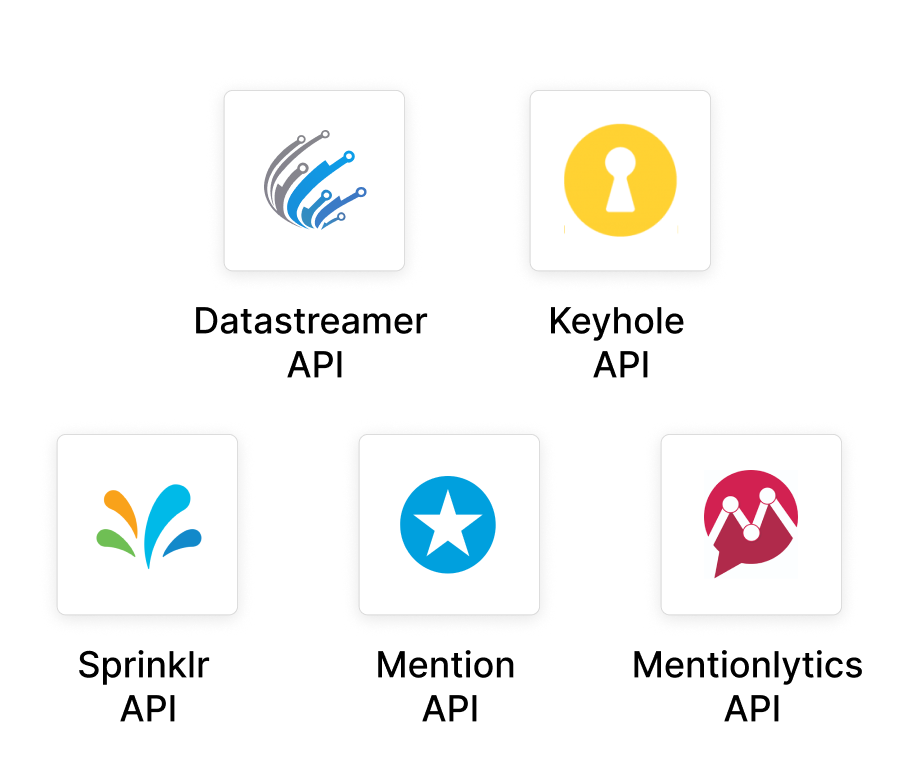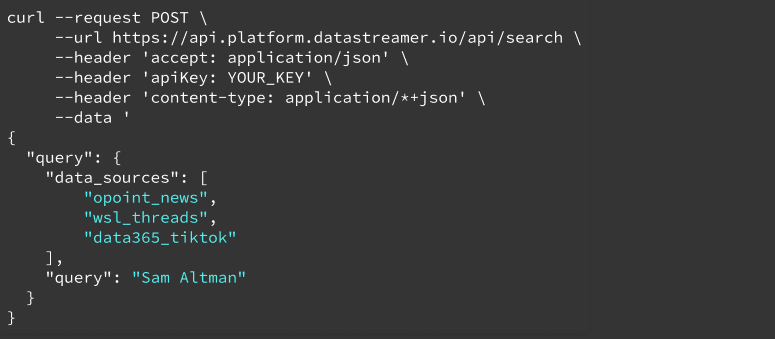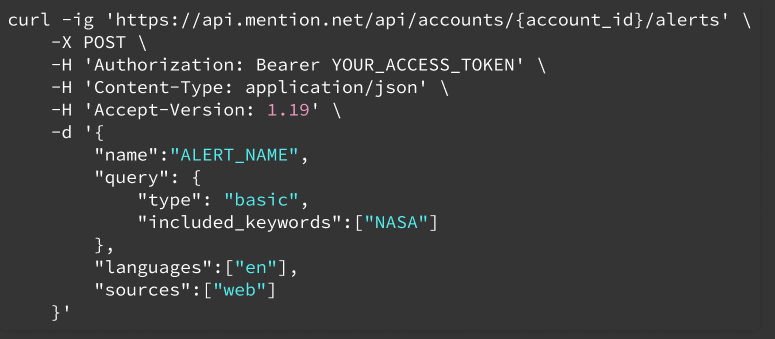2024’s Top Social Media Monitoring APIs | Build Custom Tools with These Data Feeds

Written by: Juan Combariza
Updated September 19 2024 | 8 min. read

Table of Contents
Top Picks: Best Social Media Monitoring APIs
- For integrating external data into your own systems: Datastreamer API
- For API + visual interface: Keyhole API
- For monitoring brand mentions: Mention API
- For monitoring + publishing capabilities: Sprinklr API
Why APIs over No-Code UI's?

The Demand for Control & Flexibility
Traditional UI-based platforms have been the cornerstone of social media listening insights for years, and make it effortless for non-technical users to set up queries with zero code. On the other hand, APIs offer a higher degree of control and flexibility. With APIs, teams have the capacity to work with data in a manner that standard UI platforms can’t match, transitioning from providing broad insights to tailored intelligence tools that are informed by unique domain expertise.
This is critical for teams that want to integrate complex data sets into their own proprietary systems or develop customized analytics tools.
Building Custom Social Listening Tools
In a study conducted by SIL, it was found that a majority of social listening professionals, about 55%, rely on multiple tools, and nearly a quarter are weighing the option of developing in-house technologies. This highlights the challenge that social listening departments face in identifying a tool that satisfies their full breadth of requirements straight out-of-the-box.
This is where customizable APIs step in, empowering teams looking to:
- Add media monitoring features to your SaaS products or services. Consumer insights platforms, PR tools, or marketing agencies can build a front-end interface on top of an API and offer social listening as a new product offering.
- Connect external data into internal systems (i.e. data warehouses, analytics tools, dashboards, reports). For example – an intelligence department might be seeking to develop custom dashboards that merge social media insights with internal data, alerting stakeholders of market triggers for new business opportunities.
- Train and run custom AI models with filtered, structured text data at massive scale. We’ve collaborated with an organization that developed an AI model to forecast consumer trends based on social media content. This innovative model is now used to feed R&D insights to Fortune 500 CPG customers.
Social Media Data Scrapers vs. Social Media Listening
Most media monitoring platforms essentially repackage data gathered by various scraping providers, adding enhancements such as user-friendly querying interfaces that are undoubtedly valuable to certain users.
One approach to reduce vendor costs is to go straight to data collectors like Socialgist, Webz, DarkOwl, and Data365 – which are some of the data providers used by market giants like Sprinklr and Brandwatch. But working directly with these providers can skyrocket labor costs due to the engineering work of building and maintaining the data pipelines that connect these API feeds into your systems.
The ideal approach for teams that want rapid integration of multiple vendors is to use a platform that offers pre-built, managed connectors between data providers and your products/internal systems.
Building Custom Social Listening for Your Clients?
After helping over a dozen companies incorporate custom pipelines for social listening, we see product teams face the same blockers during evaluation. Our experts can guide you in:
- Procuring and creating pricing scenarios for different web & social data sources
- Understanding how custom AI & data engineering components differentiate your insights from traditional tools like BrandWatch
To save you the unnecessary sales calls, we’ll build you a live pipeline to showcase how our platform helps insights agencies & dev. teams elevate the data capabilities you offer to clients.
The Best APIs to Feed Social Monitoring Data into Your Own Systems
1. Datastreamer API

This API call collects data from 3 separate data vendors and then funnels this compiled information to your specified destination.
Datastreamer helps you rapidly integrate social media monitoring feeds from any data vendor into your products – from a single API.
Beyond eliminating the need to build your own crawlers, Datastreamer also automates the pipelines that deliver external data into your products in a structured format that matches your internal requirements.
Datastreamer is not a data collector, but instead acts as a bridge that connects your data products to a wide selection of industry leading data suppliers. This pipeline platform is the trusted infrastructure that delivers web & social media data to market leaders like BlackSwan Data and SEMRush.
Pre-Built Connectors to Data Vendors & Databases
Implement Datastreamer into your infrastructure once, and then adding new data sources to your pipelines becomes as simple as tweaking an API parameter.
We also offer connectors that deliver data into popular destinations:
- BigQuery
- Other analytics tools (i.e. MongoDB)
- Data Warehouses (i.e. Snowflake, Databricks)
Automated Pipelines & ETL
Most ETL tools don’t support unstructured data, so Datastreamer set out to develop a straightforward solution specifically designed for handling the complexities inherent in web and social media text data.
Our partners supply the building blocks (data sources & data operations), and we provide the platform to stitch them together into robust pipelines that feed your products with continuous data. Pipeline management capabilities include real-time streaming, customizable data transformations, workflow orchestration, monitoring & debugging features + more.
NLP & LLM Enrichments
Datastreamer offers advanced AI models that are immediately ready for deployment to filter and refine data. These specialized NLP models can be set up in a familiar Boolean Query format but obtain a significantly greater accuracy than relying solely on keyword-based searches.
Additionally, there are a catalog of “operations” that go beyond filtering to unlock additional layers of value from your data:
- Content translation, sentiment analysis, ESG classifiers, and location inference.
- PII (Personally Identifiable Information) redaction to comply with GDPR or other compliance regulations.
- AI models from Google, Cohere, OpenAI + more.
Datastreamer Pros
- Affordability: A usage-based pricing model allows you to start with minimal upfront costs and gain volume discounts as you scale. Datastreamer doesn’t markup prices or white-label data from data collector partners.
- Pipeline Capabilities: Crafted intentionally to feed web & social data into your SaaS products or custom analytics, Datastreamer helps you deploy enterprise-grade pipelines without a dedicated engineering team required to build them.
- Compatibility with internal systems: Incoming data is automatically transformed into a structured format that matches your internal requirements.
- Procurement Flexibility: Test, add, remove, or scale usage volume up from different data providers without complex vendor negotiations each time.
Datastreamer Cons
- As an API-centered platform, the visual interface to build pipelines has limited features.
- While minimal engineering time is required, it is necessary to have at least one technical team member to test and deploy pipelines.
Data Sources:
View the full catalog
- Twitter (X), Facebook, Instagram, YouTube, LinkedIn, TikTok, Threads
- News, Blogs, and Forums
- Review Sites
- Dark Web & Deep Web
- VKontakte, 4Chan, Discord
You can request new sites through one of our data collection partners.
Developer Details
- Output format: JSON
- Query with Boolean Search
- Data is transformed into a structured schema.
- Link to API Documentation
- View Metadata Fields
Datasteamer API – Pricing:
Datastreamer API – Free Trial
- 14-day, API access trial available with data credits included.
- Alternatively, query sample data on a free-forever Sandbox plan.
2. Keyhole API

Sample request created by our writers based on documentation. This is not an official code snippet from Keyhole.
Keyhole is rapidly growing in popularity as a social media analytics tool. It enables the analysis of various profiles, brand mentions, campaigns, and influencers in real time.
Through its API, Keyhole provides the ability to retrieve data from sources such as Twitter and YouTube, to build or strengthen your own data systems.
Additionally, it allows for the tracking of conversations around any topic – whether a brand, product, hashtag, or campaign – by setting up real-time hashtag and keyword trackers. Ultimately, this enables you to add more data to your apps, reports, or create custom analytics systems.
Data Sources:
- Twitter (X), Facebook, Instagram, YouTube, LinkedIn, TikTok
- News, Blogs, and Forums
Developer Details
- Output format: JSON
- Link to API Documentation
Keyhole API – Pricing
API access requires an enterprise plan, which starts at $10,000/year.
Keyhole API – Free Trial
Keyhole offers a 7 day free trial to their primary analytics tool – However, accessing the API requires booking a demo.
3. Mention API

Sample request created by our writers based on documentation. This is not an official code snippet from Mention.
Mention provides a comprehensive solution for brands and agencies to track online content, understand audience sentiments, and handle social media management.
Beyond its intuitive visual interface, Mention offers a real-time API for media monitoring, granting direct access to a wide array of social media and web data without the need for creating individual crawlers.
This API empowers developers to receive up-to-the-minute monitoring data. You can customize feeds with specific entities (like brand names), keywords, or location & language – and then push these insights into reports, CRM systems, or live websites.
Data Sources:
- Facebook, Twitter (X), Instagram, YouTube
- Pinterest, TikTok, LinkedIn Company Pages
- News, Blogs, and Forums
- Review Sites
Developer Details
- Output format: JSON
- Query with Boolean search
- Link to API Documentation
Mention API – Pricing
Mention API access is available on the highest tier “Company” plan which requires a custom quote.
Mention API – Free Trial
Getting access to the Mention API requires a demo call. Mention does not specify a free trial option for their custom enterprise plan.
4. Phyllo API

Designed for the creator economy, Phyllo offers a potent API that excels in social monitoring and influencer marketing data analysis. It provides access to a broad array of social platforms, coupled with features for automated posting and verifying social identities.
One significant limitation is the lack of access to independently gathered data, which may hinder efforts to monitor keywords or indirect brand/product mentions effectively. Nevertheless, if your monitoring focuses on a specific list of managed social accounts, this tool serves as an excellent choic
Data Sources:
- Facebook, Twitter (X), Instagram, TikTok
- YouTube, Reddit
- Etsy, Shopify
Phyllo is limited to data from official platform API streams and does not perform independent third-party data collection.
Developer Details
- Output format: JSON
- Does not support keyword monitoring with Boolean logic
- Link to API Documentation
Phyllo API – Pricing
Phyllo’s pricing information is not disclosed publicly. You’ll need to request a custom quote for pricing details.
Phyllo API – Free Trial
Phyllo does not offer a free trial. You can sign up for sandbox access to explore its API environment, but this does not include production-level access to their platform.
5. Mentionlytics API

Sample request created by our writers based on documentation. This is not an official code snippet from Mentionlytics.
With Mentionlytics, businesses have access to a powerful tool that specializes in tracking online mentions across brands, products, and competitors.
The Mentionlytics API allows for the creation of custom-made integrations or dashboards, incorporating a wealth of social and internet data. For customized reporting, users can benefit from its integration with Looker Studio.
With countless discussions unfolding online, tracking hashtags and keywords becomes a powerful tool to identify the ones centered on your brand. Receiving prompt notifications whenever your customers engage with your specific keywords will proactively keep you in the loop.
Utilizing an API as your digital doorway spares you the effort and resources needed to create data crawlers.
Data Sources:
- Facebook, Twitter (X), Instagram, LinkedIn, YouTube
- Quora, Reddit
- Forums, Blogs, News
- Review sites
Developer Details
- Output format: JSON
- Filter with Boolean search
- Link to API Documentation
Mentionlytics API – Pricing
Mentionlytics API access is available on “Advanced” plans or higher, which starts at $2500/yr.
Mentionlytics API – Free Trial
Mentionlytics offers a free trial for their “Advanced” plan, but API access is only granted upon request.
6. Determ API
Determ is a powerful media monitoring tool that helps you collect all conversations about your brand and industry in one place.
Its API facilitates enriched data incorporation into your digital platforms, with a special focus on immediate news updates
It also provides an extensive range of metadata and customizable filters like date, location, language, and sentiment for precise data feeds.
Data Sources:
- Facebook, Twitter (X), Instagram, TikTok
- YouTube, VKontakte, Reddit
- Forums, Blogs, News, Websites
- Review sites
Developer Details
- Output format: JSON
- Filter with Boolean search
- Historical Data Included
Determ API – Pricing
Using Determ’s API to push media monitoring data into your own systems is a available as an add on that requires a custom quote.
Determ API – Free Trial
Determ offers a free trial for their platform, but this does not include access to the API.
API Alternatives to Sprinklr, Brandwatch, & Meltwater
In the realm of social listening, platforms like Sprinklr have long been preferred for setting up brand monitoring queries and social channel alerts.
However, a significant drawback is that these major players, including Sprinklr, Brandwatch, and Meltwater, reserve API access for their enterprise-level plans. These premium plans, often requiring custom quotes, start at around $8,000/year based on user reports, with a majority of users reporting higher annually costs. Furthermore, these providers don’t offer a straightforward route to a free trial with API access.
It’s important to recognize that these large companies don’t primarily focus on API services and generally don’t engage in data scraping themselves. This means that, despite their renown, they might not meet the needs of those looking to extensively push data into their own systems
However, for larger organizations or agencies seeking an API with a broad array of features like social media monitoring, content publishing, and PR campaign management, these platforms, despite their high cost, could be considered among the top options
How to Choose a Social Monitoring API
Besides the fundamental questions about included data sources and pricing, you should also consider the following criteria when choosing a social listening API:
Questions to Ask Vendors (click to expand)
2. Real-Time Update Frequency Ask vendors, “How often will my data streams be updated with the most recent information?” This update frequency often varies based on your pricing plan, with some providers offering hourly updates or near real-time updates every minute.
3. Historical Search Length Ask vendors, “How far back can I perform historical searches?” This capability can sometimes be an add-on or vary based on your pricing plan. Note that newer social listening APIs might only have data going back 6-12 months, reflecting the time they started collecting data.
4. Ability to Customize Collection Ask vendors, “Can I customize my collection criteria, such as adding a new metadata field or monitoring a list of accounts more frequently?” This feature typically incurs additional costs but can be invaluable for specific monitoring needs.
5. Ease of Integration / Developer Friendliness Assessing the ease of integration is crucial for seamless data handling. It’s recommended to thoroughly review the API documentation and gauge technical difficulty during demos or trials. While most social listening APIs offer well-maintained environments, there are horror stories of overly complex APIs that delay implementation by months.
6. Enrichment Capabilities Ask vendors, “What enrichments are natively available with this API?” Enrichments refer to additional data processing features like sentiment analysis and entity recognition. Some platforms offer advanced enrichments such as location inference, intent classification, or ESG classification, adding significant value to the raw data collected.
Frequently Asked Questions
Is there a free social media API (like Twitter)?
As of 2024, all major platforms like Facebook, Twitter, and TikTok do not offer free APIs for social listening data. Accessing social media data from these platforms typically requires using third-party tools or subscribing to their premium APIs.
While third-party data collectors may provide free tiers, trials, or datasets, these come with limitations and eventually require payment for complete functionality.
How to visualize social listening data
The APIs listed here gather millions of unstructured data points and convert them into structured JSON data, simplifying the process of exporting this data to your preferred visualization tool.
If you offer a social listening product or service, this structured data can be directly ported to custom-built dashboards on your platform or through a data warehouse like Databricks as an intermediary. Additionally, you can export the data to business intelligence tools such as Tableau or Looker Studio to create shareable reports and visualizations.
Common visualization insights include graphs, charts, and heat maps that reveal trends, sentiment analysis, or engagement metrics.
How to access raw social media data
Many social listening APIs restrict you to their curated data feeds, but APIs like Datastreamer give you the capability to ingest unfiltered, raw social media data. Developers generally apply filters to this raw data, either to enhance its value or to lower processing demands. The data is usually formatted as JSON, allowing for seamless integration and manipulation within your own data environment
What are the benefits of using a social listening API?
By integrating data on brand mentions, trends, sentiment, influencer reach, and competitive dynamics in real-time, these APIs allow developers, marketing firms, and analytics platforms to build customized social listening tools for their clients. Social listening insights are typically leveraged by end-users to respond swiftly to customer feedback, gain an understanding of industry trends, inform new product launces, and track marketing success.
API to create a white label social listening tool
All of these API options are intended to feed data into the insights solutions you provide to your clients, covering critical aspects of the data lifecycle like acquisition, enrichment, and delivery. That said, you’ll still need to build out the user interface, visualizing the insights, and potentially adding other backend components. These APIs streamline the data handling process, making it easier for you to develop a complete social listening tool.
Social Listening v.s. Media Monitoring
Social listening focuses on tracking and analyzing conversations across social media platforms, blogs, and online communities to understand customer sentiment, identify trends, and engage with audiences in real-time. In contrast, media monitoring encompasses a broader range of sources, including traditional media like newspapers, TV, radio, and digital news sites, to track mentions of specific topics or entities, primarily for PR and reputation management.
Is it legal to use a Social Listening API?
Social listening APIs are widely adopted by large enterprises and generally considered safe for use. While they eliminate the need for direct data scraping, it’s crucial to handle and process the data in a compliant manner. This involves adhering to relevant privacy regulations and platform-specific Terms of Service. Conducting thorough due diligence on these legal requirements is essential to ensure that your use case remains compliant.
- Terms of Service: Each social media platform has its own set of rules and terms for API usage. For example, platforms like Twitter, Facebook, and Instagram have specific guidelines on what data can be collected, how it can be used, and who can access it.
- Privacy Compliance: In the context of this blog, all data is public data that is posted by users. You should still conduct research into what privacy laws apply to your jurisdiction. You can ask vendors in your data supply chain if they comply with privacy regulations such as GDPR and CCPA.
- Intended Use and Restrictions: Legality also hinges on how the collected data is used. Using it for malicious purposes, such as harassment or discrimination, would be illegal.
